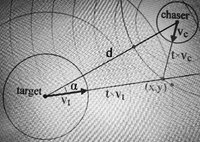Mosab Ahmed
New member
- Joined
- Nov 24, 2020
- Messages
- 1
Hello ;
I need to find the formula to find the point of intersection (x,y) of two moving objects.
if we know there current location and the distance between them , and the velocity for each of them as illustrated in the picture.
- I believe the formula has to consider the angle ( theta)
How to find the point of collision between two moving objects in 2d plane .. if we know :
- the current position of both object
Object1 in ( a1,b1)
Object2 in (a2,b2)
the velocity for both object
The distance between them
I need to find the formula to find the point of intersection (x,y) of two moving objects.
if we know there current location and the distance between them , and the velocity for each of them as illustrated in the picture.
- I believe the formula has to consider the angle ( theta)

How to find the point of collision between two moving objects in 2d plane .. if we know :
- the current position of both object
Object1 in ( a1,b1)
Object2 in (a2,b2)
the velocity for both object
The distance between them

